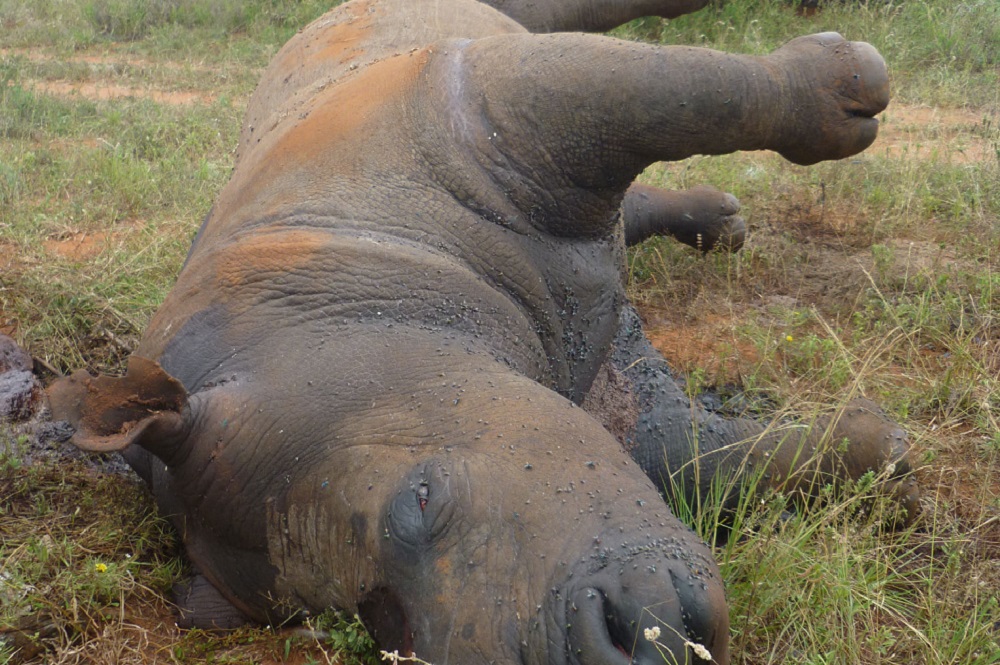

Credit: Sarah Nelson
Poaching for rhino horn
Rhino poaching is being driven by the demand for rhino horn in Asian countries, particularly China and Viet Nam.
Rhino horn is used in Traditional Chinese Medicine, but increasingly common is its use as a status symbol to display success and wealth. Poaching is now a threat in all rhino range states, however, as South Africa is home to the majority of rhinos in the world, it is being heavily targeted. Together with our partners, we’re investing in activities to stop poaching on the ground, whilst simultaneously investigate and disrupt the international crime syndicates responsible.
Rhino poaching is not merely the work of opportunistic criminals; it is part of a complex web of illicit networks that span national and continental borders. The people involved undertake different forms of illegal activities, from tracking and killing rhinos in protected areas to smuggling their horns and sourcing global buyers. Disrupting these intricate networks requires multifaceted approaches and international partnerships. Recent arrests and successful prosecutions in South Africa and other key rhino countries including Indonesia, underscores the importance of global collaboration to combat the illegal wildlife trade.
The scarcity of rhinos and the corresponding intermittent availability of rhino horn only drives the price of horn up, intensifying pressure on declining rhino populations. Find out the latest poaching statistics.
Donate to help stop poaching.
What is rhino horn?
Rhino horns are similar in structure to horses’ hooves, turtle beaks, and cockatoo bills. They are made of keratin – in rhinoceros horn, it is chemically complex and contains large quantities of sulphur-containing amino acids, particularly cysteine, as well as tyrosine, histidine, lysine, and arginine, and the salts calcium carbonate and calcium phosphate.
Traditional Chinese Medicine
According to traditional Chinese texts, such as Li Shih-chen’s 1597 medical text “Pen Ts’ ao Kang Mu”, rhino horn has been used in Chinese medicine for more than 2,000 years and is used to treat fever, rheumatism, gout, and other disorders. It also states that the horn could also cure snakebites, hallucinations, typhoid, headaches, carbuncles, vomiting, food poisoning, and “devil possession.” While it is commonly believed to be prescribed as an aphrodisiac, this is not the case.
When used, the horn is shaved or ground into a powder, before being dissolved in boiling water and consumed.
As Richard Ellis, author of “Tiger bone and rhino horn” wrote in 2005 for the EAZA Rhino Campaign’s Info Pack: “It is not clear that rhino horn serves any medicinal purpose whatsoever, but it is a testimony to the power of tradition that millions of people believe that it does. Of course, if people want to believe in prayer, acupuncture or voodoo as a cure for what ails them, there is no reason why they shouldn’t, but if animals are being killed to provide nostrums that have been shown to be useless, then there is a very good reason to curtail the use of rhino horn. There are five species of rhinoceros and, with the exception of one subspecies of African White rhino, all are in danger of being hunted to extinction for their horns. Rhinos, as we know them, have been around for millions of years, but Dr H. Spaiens has created a predicament from which they might never recover. It is heartbreaking to realise that the world’s rhinos are being eliminated from the face of the earth in the name of medications that probably don’t work.”
Aphrodisiac
There is a belief in Western countries that rhino horn is used as an aphrodisiac and sexual stimulant, but this is not correct and seems to have been misunderstood or misinterpreted by Western media. However, research has shown that people in Viet Nam are starting to believe this rumour as they are consuming it for new reasons.
Even without aphrodisiacal properties, however, rhino horn is one of the mainstays of Traditional Chinese Medicines, and its collection has been responsible for the death of tens of thousands of rhinos around the world.
Make no mistake: those people using rhino horn to cure medical ailments really believe it works. That’s what drives up the demand on which the poachers thrive. As Ann and Steve Toon commented in 2002, “For practitioners of traditional Asian medicine, rhino horn is not perceived as a frivolous love potion, but as an irreplaceable pharmaceutical necessity.”
Viet Nam – new uses for rhino horn
There has been a recent surge in demand for rhino horn in Viet Nam. A survey, carried out by TRAFFIC in 2013, identified that the motivation for consumers buying rhino horn is the emotional benefit rather than medicinal, as it reaffirms their social status among their peers. Image and status are important to these consumers, as they tend to be highly educated and successful people who have a powerful social network and no affinity to wildlife. Rhino horns are sometimes bought for the sole purpose of being gifted to others; to family members, business colleagues or people in positions of authority.
TRAFFIC identified three main consumer groups. You can read their report here.
Trade
The international trade in rhino horn has been banned under CITES (Convention on International Trade in Endangered Species of Fauna and Flora) since 1977. In South Africa it is possible to trade rhino horn domestically (within the country), after a legal battle to overturn the ban took place in 2017. There are wider calls from within the country to legalise the international trade in rhino horn.





